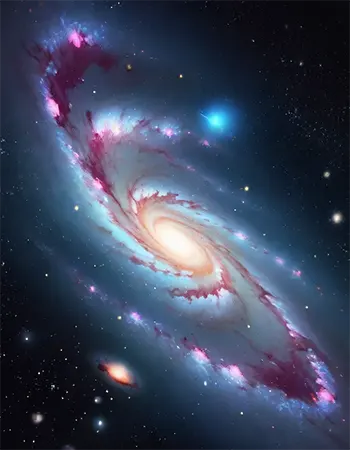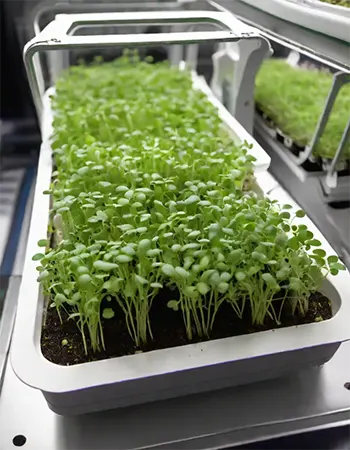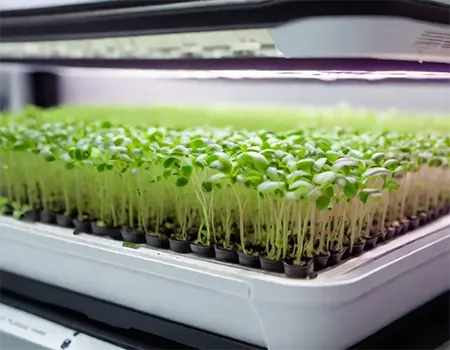Microgreens are Out of This World! How NASA is Growing Food for the Future

The challenges of long-duration space missions necessitate innovative solutions for food production. Microgreens, small seedlings harvested after their initial true leaves develop, are emerging as a promising option for NASA's space program. Their potential benefits include:
- High Nutritional Value: Microgreens are often touted as "nutrient powerhouses," packing concentrated vitamins, minerals, and antioxidants into their tiny forms. This aligns with the need for astronauts to maintain optimal health during extended space travel.
- Efficient Growth: Microgreens require minimal space and resources to grow, thriving in controlled environments with limited soil and water. This makes them ideal for compact spacecraft with constrained resources.
- Rapid Harvest: Their quick growth cycle - often ready within 7-10 days - ensures a steady supply of fresh produce, alleviating dependence on pre-packaged, shelf-stable options.
- Versatility: Microgreens offer a diverse range of flavors and textures, enhancing the culinary experience in space and potentially improving dietary adherence among astronauts.
This research into microgreens holds significant potential for future space missions, offering a sustainable and nutritious food source for astronauts venturing further into the cosmos.
Cosmic Challenges: The Quest for Sustainable Space Sustenance:
Long-duration space missions present unique challenges when it comes to feeding astronauts. Traditional food options pose several problems:
- Limited Shelf Life: Fresh fruits and vegetables quickly spoil, requiring bulky refrigeration and contributing to food waste.
- Weight Woes: Every gram counts in space travel. Transporting heavy, pre-packaged meals adds significant weight and cost.
- Nutritional Deficiencies: Astronauts face increased risks of bone loss, muscle atrophy, and weakened immune systems, requiring a balanced and nutrient-rich diet.
Microgreens: Addressing Challenges and Enhancing Space Diet
Microgreens present a compelling solution to several food-related challenges encountered in space missions:
- Enhanced Nutritional Profile: Despite their diminutive size, research indicates microgreens contain significantly higher concentrations of nutrients per gram compared to their fully grown counterparts. They are rich in vitamins, minerals, antioxidants, and essential elements crucial for astronaut health and immune function.
- Accelerated Production: Unlike traditional vegetables requiring months to reach maturity, microgreens can be harvested within a mere 7-14 days. This rapid growth cycle aligns perfectly with the resource constraints and limited fresh produce availability inherent to space missions.
- Space-Efficient Cultivation: These compact crops necessitate minimal growing space. Thriving in vertically stacked modules, they maximize yield while minimizing water, energy, and soil consumption compared to conventional farming methods. This aspect is critical for resource-limited spacecraft and future lunar or Martian outposts with restricted resources.
- Versatility and Flavor Enhancement: Beyond nutritional value, microgreens offer a welcome sensory experience in the often bland environment of space food. Their diverse range of flavors and textures, encompassing peppery radish to sweet pea shoots, inject excitement and variety into the astronaut's diet, potentially improving morale and encouraging overall food intake.
Beyond Basic Sustenance: Microgreens for Health and Well-being in Space:
The benefits of microgreens extend beyond basic nutrition. Research suggests they may hold promise for:
- Enhanced Immune System: The concentrated presence of antioxidants and phytonutrients may help strengthen the immune system, critical for astronauts exposed to radiation and microgravity.
- Improved Gut Health: Studies indicate microgreens can promote the growth of beneficial gut bacteria, essential for maintaining digestive health and overall well-being.
- Mental Health Benefits: Access to fresh, vibrant food can have a positive impact on mood and cognitive function, crucial for astronauts enduring the mental challenges of long-duration space travel.
Looking Ahead: Microgreens - A Sprout of Hope for the Future of Space Food:

NASA's ongoing research on microgreens paves the way for a future where astronauts enjoy fresh, nutritious, and flavorful food on extended missions. From developing new varieties with optimal nutritional profiles to optimizing growing systems for space environments, the possibilities are endless.
Unlocking Microgreen Potential: Ongoing Research at NASA
NASA's commitment to microgreens extends beyond recognizing their potential - active research efforts are underway to fully unlock their capabilities for space travel and optimize their growth and nutritional value. Let's delve into the fascinating world of NASA's microgreen investigations:
Optimizing Growth in Space Environments:
- Controlled Environment Agriculture (CEA) Systems: Researchers are developing and testing specialized modules designed to grow microgreens in microgravity and closed-loop environments. These systems meticulously control factors like lighting, temperature, humidity, and nutrient delivery to maximize yield while minimizing resource consumption.
- Hydroponics and Aeroponics: Traditional soil-based agriculture is impractical in space. NASA is exploring hydroponic and aeroponic techniques, where microgreens grow in nutrient-rich water solutions or mist, respectively. These methods require less water and offer precise control over nutrient delivery, crucial for maximizing efficiency in constrained environments.
- LED Lighting Solutions: In the absence of natural sunlight in space, NASA is meticulously testing various LED lighting spectra to identify the optimal wavelengths for microgreen growth. This ensures proper photosynthesis and nutrient production, vital for plant health and nutritional content.
Enhancing Nutritional Value and Developing Space-Specific Varieties:
- Biofortification: Scientists are investigating ways to naturally increase the nutritional content of microgreens through biofortification techniques. This involves breeding selected varieties with higher levels of specific vitamins, minerals, or antioxidants relevant to astronaut health. This targeted approach enhances the nutritional value of microgreens, further bolstering their contribution to astronaut dietary needs.
- Microbiome Optimization: Research is exploring the role of the microbiome (the community of microorganisms) in microgreen growth and nutrient uptake. Optimizing the microbiome could further enhance their nutritional value and resilience in closed-loop space environments.
- Developing Space-Specific Varieties: Not all microgreens are created equal for space travel. NASA is collaborating with plant breeders to develop new varieties specifically suited for space environments. These varieties prioritize traits like faster growth cycles, tolerance to microgravity, and resistance to diseases in closed systems, addressing key challenges encountered in space agriculture.
Beyond Earthly Applications:
While the primary focus is on space travel, NASA's microgreen research has broader implications:
- Sustainable Food Production: The resource-efficient nature of microgreen cultivation has applications for sustainable food production on Earth, especially in urban areas with limited land and water resources.
- Combating Food Insecurity: The rapid growth and high nutritional content of microgreens offer potential solutions for addressing food insecurity in underprivileged communities worldwide.
- Precision Agriculture: The advancements in CEA systems and controlled environments developed for space could translate to improved precision agriculture practices on Earth, optimizing resource use and crop yields.

The Future is Green (and Tiny):
NASA's ongoing research on microgreens is not just about feeding astronauts on distant missions; it's about pushing the boundaries of agriculture and food production for the benefit of all. These tiny titans hold the potential to revolutionize the way we grow, consume, and appreciate food, both on Earth and beyond.
From Seedlings to Stars: A Peek into NASA's Microgreen Projects:
NASA's commitment to microgreen research isn't just theoretical; it's translating into concrete projects exploring various aspects of their potential:
1. VEG-05: Sprouting Success on the ISS:
- This ongoing project aboard the International Space Station (ISS) utilizes the Vegetable Production System (Veggie) - a specialized plant growth chamber.
- Astronauts cultivate various microgreens, including red romaine lettuce, Mizuna mustard, and dwarf sunflowers, gaining valuable insights into their growth in microgravity.
- The project recently tested a seed film technology, embedding seeds in a water-soluble polymer for easier handling and planting in space.
2. Growing Beyond Earth: Bringing Microgreens to Classrooms:
- This citizen science program partners with NASA and Fairchild Tropical Botanic Garden to engage students in microgreen research.
- Students test different growing methods and plant varieties, contributing to the understanding of microgreen cultivation in space-like environments.
- The program fosters STEM education and inspires future generations to explore the possibilities of space agriculture.
3. Microgravity Harvesting: Taming Tiny Titans:
- This project investigates the challenges of harvesting microgreens in microgravity. Researchers test various tools and techniques to minimize debris and ensure efficient harvesting without damaging the plants.
- The knowledge gained will be crucial for future space missions where astronauts need to maximize their food production and minimize waste.
4. Nutritional Analysis: Powering Up with Microgreens:
- Scientists analyze the nutritional content of microgreens grown in various conditions, both on Earth and in space simulations.
- This research aims to identify varieties with the highest nutrient density and explore ways to further enhance their nutritional value for astronauts' specific needs.
5. Closed-Loop Systems: Toward Self-Sufficient Space Farming:
- This project develops and tests closed-loop systems for growing microgreens, where water and nutrients are recycled and reused efficiently.
- This research is critical for future long-duration missions where resources need to be carefully managed and conserved.
Beyond these specific projects, NASA actively collaborates with universities, research institutions, and companies to push the boundaries of microgreen technology and cultivation. Through these efforts, these tiny seedlings are blossoming into promising solutions for food production in space and on Earth.
Microgreen Adventures: Navigating the Cosmic Challenges
While the potential of microgreens for space travel is undeniable, cultivating these tiny titans in the harsh environment of space comes with its fair share of challenges. Let's explore some of the biggest hurdles NASA is facing and their ingenious solutions:
- Root Growth and Nutrient Uptake: Research suggests microgravity disrupts root growth patterns, leading to shorter and thicker roots with fewer root hairs. This hinders nutrient and water uptake, impacting plant health and yield.
- Solutions:
- Hydroponics and Aeroponics: Eliminating gravity's role in root growth, these systems provide direct access to nutrients and water, promoting healthy root development.
- Novel Root Support Structures: Gels, foams, and grids offer physical support and guidance for roots, encouraging them to grow in desired directions and maximize nutrient uptake.
- Microgravity Simulation Studies: Earth-based parabolic flights and specialized centrifuges help researchers understand root behavior in microgravity and test potential solutions.
2. Harvesting in a Weightless World:
- Tiny Debris, Big Problem: Even the smallest leaf fragments can become dangerous projectiles in microgravity, posing risks to equipment and astronaut health. Traditional cutting methods like scissors can exacerbate this issue.
- Solutions:
- Enclosed Harvesting Chambers: Self-contained units with filters or vacuum systems capture plant material during harvest, preventing debris from floating around.
- Specialized Harvesting Tools: Vacuum-assisted devices gently suction microgreens, minimizing damage and debris creation.
- Breeding for Sturdier Stems: Selecting and breeding varieties with thicker, less brittle stems reduces the risk of breakage during harvest, minimizing debris.
3. Lights Out, Growth Slowdown:
- Limited Sunlight: Unlike Earth's natural light cycle, spacecraft rely on artificial LED lighting. Finding the optimal light spectrum and intensity is crucial for photosynthesis and plant growth.
- Solutions:
- Testing Different LED Lighting Systems: Researchers are experimenting with various wavelengths and intensities, mimicking natural sunlight as closely as possible for optimal plant development.
- Supplementing with UV Radiation: Studies explore the potential of adding low-dose UV radiation to enhance plant health, stimulate specific nutrients, and combat potential fungal growth.
- Scarce and Precious: Water is a limited resource on spacecraft, and traditional soil-based farming consumes significant amounts. Optimizing water usage is crucial for sustainable microgreen production.
- Solutions:
- Closed-Loop Hydroponic Systems: These systems recycle and reuse water efficiently, minimizing waste and maximizing water availability for plant growth.
- Misting and Fogging Techniques: By creating a humid environment around the plants, these methods reduce water evaporation and optimize plant hydration with minimal water usage.
- Developing Drought-Resistant Varieties: Selecting and breeding microgreen varieties with higher water-use efficiency helps conserve this precious resource in space.
5. Micromanaging the Microbiome:
- Space is Not Sterile: The closed environment of a spacecraft harbors unique microbial communities. While some microbes can be beneficial, others may pose health risks or impede plant growth.
- Solutions:
- Understanding the Microbiome: Ongoing research aims to identify and characterize the unique microbiome of spacecraft and its impact on microgreen health.
- Promoting Beneficial Microbes: Introducing specific beneficial microbes or prebiotics can help control harmful ones and create a balanced microenvironment for healthier plant growth.
- Sterilized Growing Materials and Nutrient Solutions: Maintaining sterile conditions during planting and throughout the growth cycle minimizes the risk of harmful microbial contamination.
6. Flavor Fiesta or Bland Bites?
- Space Stress and Altered Taste: Astronauts in space often experience altered taste perceptions due to a combination of physiological and psychological factors, potentially leading to decreased appetite and food intake.
- Solutions:
- Selecting and Breeding Flavorful Varieties: Choosing microgreens with diverse and appealing flavors and textures, like spicy radishes or sweet pea shoots, caters to potentially altered taste perceptions and encourages consumption.
- Exploring Sensory Science: Studying how flavors and textures are perceived in space can inform microgreen selection and recipe development for enhanced astronaut enjoyment.
- Adding Flavor Boosters: Utilizing spices, herbs, or condiments alongside microgreens can further enhance their appeal and encourage a diverse and enjoyable diet.
Remember, this is an ongoing journey for NASA. As they overcome these challenges, microgreens hold immense potential to revolutionize space food and contribute to the long-term success of space exploration.

